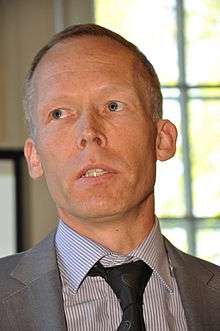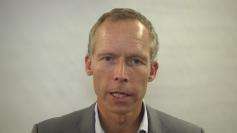Johan Rockström
| Johan Rockström | |
|---|---|
 | |
| Fields | Global sustainability and water resources |
| Institutions | Stockholm University and the Stockholm Resilience Centre |
| Known for | Leading development on the Planetary Boundaries framework |
| Notable awards | The Woods Hole Research Center's Lawrence Huntington Environmental Prize, November 6, 2014 |

Johan Rockström is executive director of the Stockholm Resilience Centre, and teaches natural resource management at Stockholm University. He is a strategist on how resilience can be built into land regions which are short of water, and has published over 100 papers in fields ranging from practical land and water use to global sustainability.[1] Johan Rockström was Executive Director of the Stockholm Environment Institute from 2004-2012.
Rockström is internationally recognized on global sustainability issues. In 2009, he led the team which developed the Planetary Boundaries framework, a proposed precondition for facilitating human development at a time when the planet is undergoing rapid change.[2] In recognition of this work, Fokus magazine named him "Swede of the Year" for "engaging and exciting work in sustainable development.[3] Rockström is vice-chair of the Scientific Advisory Board of the Potsdam Institute for Climate Impact Research[4] and chair of the Earth System Visioning Task Team of International Council for Science.[5] In 2010, the magazine Miljöaktuellt ranked him the second most influential person in Sweden on environmental issues, and Veckans Affärer gave him its "Social Capitalist Award".[1] In 2011 he chaired the third Nobel Laureate Symposium on Global Sustainability in Stockholm.[6]
Planetary boundaries
In 2009, Rockström led an international group of 28 leading academics, who proposed a new Earth system framework for government and management agencies as a precondition for sustainable development. The framework posits that there are Earth system processes on the planet that have boundaries or thresholds which should not be crossed. The extent to which these boundaries are not crossed marks what the group calls the safe operating space for humanity.[7] The group identified nine "planetary life support systems" essential for human survival, and attempted to quantify just how far seven of these systems have been pushed already. They then estimated how much further we can go before our own survival is threatened; beyond these boundaries there is a risk of "irreversible and abrupt environmental change" which could make Earth less habitable.[2] Boundaries can help identify where there is room and define a "safe space for human development", which is an improvement on approaches which aim at just minimizing human impacts on the planet.[2]
According to critics, the exact location of six of these "planetary boundaries" are not proven but arbitrary, such as the 15% limit of earth use to cropland. It is claimed that increased earth use has increased global well-being. They are also connected to local rather than global consequences.[8][9]
Some recent publications
- Rockström, J., Williams, J., Daily, G., Noble, A., Matthews, N., Gordon, L., Wetterstrand, H., DeClerck, F., Shah, M., Steduto, P. and de Fraiture, C., 2016. Sustainable intensification of agriculture for human prosperity and global sustainability. Ambio, pp.1-14.
- Rockström J, L Karlberg and M Falkenmark (2011) "Global Food Production in a water-constrained world: exploring 'green' and 'blue' challenges and solutions." In Grafton, R. Q. and K. Hussey (eds.) 2011. Water Resources Planning and Management. Cambridge University Press.
- Rockström J and L Karlberg (2010) The quadruple squeeze: Defining the safe operating space for freshwater use to achieve a triply green revolution in the Anthropocene. AMBIO, 39(3): 257-265. doi:10.1007/s13280-010-0033-4
- Hoff H, M Falkenmark, D Gerten, L Gordon, L Karlberg and J Rockström (eds.) (2010) Journal of Hydrology: Green-Blue Water Initiative (GBI), 384(3/4): 175-306.
- Enfors E, J Barron, H Makurira, J Rockström and S Tumbo (2010) Yield and soil system changes from conservation tillage in dryland farming: A case study from North Eastern Tanzania. Agricultural Water Management, online 7 April. doi:10.1016/j.agwat.2010.02.013
- Reid WV, D Chen, L Goldfarb, H Hackmann, YT Lee, K Mokhele, E Ostrom, K Raivio, J Rockström, HJ Schellnhuber and A Whyte (2010) Earth System Science for Global Sustainability: Grand Challenges. Science, 12 November, pp. 916–917. doi:10.1126/science.1196263
- Kijne, J, J Barron, H Hoff, J Rockström, L Karlberg, J Gowing, SP Wani, D Wichelns (2009) Opportunities to increase water productivity in agriculture with special reference to Africa and South Asia. Stockholm: SEI. SEI project report.
- Hoff H, M Falkenmark, D Gerten, L Gordon, L Karlberg and J Rockström (2010) Greening the global water system. Journal of Hydrology, 384(3/4): 177-186. doi:10.1016/j.jhydrol.2009.06.026
- Wani SP, Rockström J and Oweis TY (2009) Rainfed agriculture: unlocking the potential CABI. ISBN 978-1-84593-389-0.
- Rockström J, M Falkenmark, L Karlberg, H Hoff, S Rost and D Gerten (2009) Future water availability for global food production: The potential of green water for increasing resilience to global change. Water Resources Research, vol. 45. doi:10.1029/2007WR006767
- Rost S, D Gerten, H Hoff, W Lucht, M Falkenmark, J Rockström (2009) Global potential to increase crop production through water management in rainfed agriculture. Environmental Research Letters, no. 4, 9 pp. doi:10.1088/1748-9326/4/4/044002
- Kartha S, Siebert CK, Mathur R, Nakicenovic N, Ramanathan V, Rockström J, Schellnhuber HJ, Srivastava L and Watt R (2009) A Copenhagen Prognosis: towards a safe climate future Stockholm Environment Institute.
- Rockström J, Steffen W, Noone K, Persson Å, Chapin III FS, Lambin EF, Lenton TM, Scheffer M, Folke C, Schellnhuber HJ, Nykvist B, de Wit CA, Hughes T, van der Leeuw S, Rodhe H, Sörlin S, Snyder PK, Costanza R, Svedin U, Falkenmark M, Karlberg L, Corell RW, Fabry VJ, Hansen J, Walker B, Liverman D, Richardson K, Crutzen P and Foley JA (2009) "A safe operating space for humanity" Nature, 461: 472–475. doi:10.1038/461472a* Rockström J, Vohland K, Lucht W, Lotze-Campen H, von Weizsäcker EU and Tariq Banuri T (2007) "Making progress within and beyond borders" In: Schellnhuber H-J, Stern N and Molina M (eds) Global sustainability: a Nobel cause, Chapter 4, pages 33–48. Cambridge University Press, 2010. ISBN 978-0-521-76934-1.
- Falkenmark M and Rockström J (2004) Balancing water for humans and nature: the new approach in ecohydrology Earthscan. ISBN 978-1-85383-927-6.
- Wijkman A and Rockström J (2011) Den stora förnekelsen (Swedish), The Great Denial (English version due late 2011), new book: interview review
Notes
- 1 2 Johan Rockström Stockholm Resilience Centre. Retrieved 13 July 2011.
- 1 2 3
- Rockström J, Steffen W, Noone K, Persson Å, Chapin III FS, Lambin EF, Lenton TM, Scheffer M, Folke C, Schellnhuber HJ, Nykvist B, de Wit CA, Hughes T, van der Leeuw S, Rodhe H, Sörlin S, Snyder PK, Costanza R, Svedin U, Falkenmark M, Karlberg L, Corell RW, Fabry VJ, Hansen J, Walker B, Liverman D, Richardson K, Crutzen P and Foley JA (2009) "Planetary Boundaries: Exploring the Safe Operating Space for Humanity" Ecology and Society, 14(2): 32.
- ↑ Johan Rockstrom Sweden’s Person of Year . Resilience Science. Retrieved 13 July 2011.
- ↑ Scientific Advisory Board Potsdam Institute for Climate Impact Research. Retrieved 13 July 2011.
- ↑ Earth System Visioning International Council for Science. Retrieved 13 July 2011.
- ↑ At Stockholm Gathering of Minds: Planet Earth vs. Humanity National Geographic Daily News, 18 May 2011.
- ↑ Earth's boundaries? Editorial, Nature, 461, 447–448. 24 September 2009, doi:10.1038/461447b
- ↑ Walking the Line: How to Identify Safe Limits for Human Impacts on the Planet, By David Biello | Scientific American – Wed, Jun 13, 2012
- ↑ The Global Doomsayers' Ever-Changing Story, WSJ, June 15, 2012
External links
| Wikimedia Commons has media related to Johan Rockström. |
- Johan Rockström Stockholm Resilience Centre.
- Win-win solutions from a new Green Revolution People & Planet, 27 April 2011.
- Humanity needs to take 'giant leap' BBC News, 27 July 2010.
- Johan Rockstrom: Let the environment guide our development TED video, July 2010. Transcript html